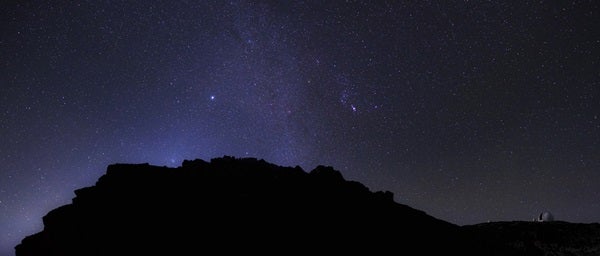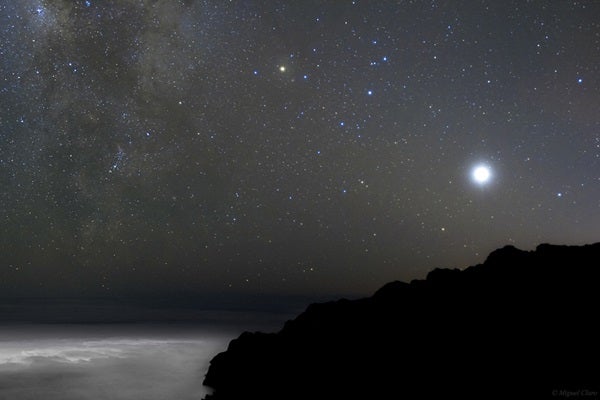The waxing crescent Moon serves as a convenient guide for finding Saturn this evening. Look for the ringed world 4° to Luna’s upper left. Of course, Saturn remains a glorious sight all week. The planet resides among the background stars of Sagittarius the Archer, a region that appears 20° high in the southwest as twilight fades to darkness and doesn’t set until 10 p.m. local daylight time. Saturn shines at magnitude 0.6 and appears significantly brighter than any of its host constellation’s stars. Although a naked-eye view of the planet is nice, seeing it through a telescope truly inspires. Even a small instrument shows the distant world’s 16″-diameter disk and spectacular ring system, which spans 36″ and tilts 25° to our line of sight.
This week offers an excellent opportunity to view the zodiacal light. From the Northern Hemisphere, early autumn is the best time of year to observe this elusive glow before sunrise. It appears slightly fainter than the Milky Way, so you’ll need a clear moonless sky and an observing site located far from the city. Look for the cone-shaped glow, which points nearly straight up from the eastern horizon, shortly before morning twilight begins (around 6 a.m. local daylight time and 5 a.m. standard time at mid-northern latitudes). The Moon remains out of the morning sky until November 11, when its bright light will return and overwhelm the much fainter zodiacal light.
Sunday, November 3
A nearly First Quarter Moon appears in the southern sky as darkness falls and remains on view until after 10 p.m. local time. Our satellite officially reaches its First Quarter phase at 5:23 a.m. EST tomorrow morning, so it looks a little less than half-lit this evening. It will appear slightly more than 50 percent illuminated tomorrow night. The Moon spends this evening among the background stars of Capricornus the Sea Goat.
For those areas of the United States and Canada that observe daylight saving time, set your clocks back one hour this morning. The official switch occurs at 2 a.m. local daylight time, which becomes 1 a.m. local standard time. The switch means sunrise and sunset both arrive an hour earlier today than they did yesterday. So, at least by clock time, the latest sunrise of the year occurred yesterday morning.
Monday, November 4
As if the earlier sunsets this week don’t put you in mind of winter, the midevening appearance of the season’s most conspicuous constellation surely will. Orion the Hunter rises in the eastern sky around 9 p.m. local time and appears halfway to the zenith in the southeast by midnight. Look for three 2nd-magnitude stars in a line that form the Hunter’s Belt. The constellation’s brightest stars are ruddy Betelgeuse and blue-white Rigel.
Tuesday, November 5
Although asteroid 4 Vesta won’t reach opposition and peak visibility until next week, it’s probably easier to find in this evening’s sky. The brightest object in the main asteroid belt, which lies between the orbits of Mars and Jupiter, Vesta passes 0.3° due south of the 4th-magnitude star Omicron (ο) Tauri in far western Taurus tonight. The asteroid currently glows at magnitude 6.5 and shows up easily through binoculars or a telescope.
Wednesday, November 6
Jupiter shines brilliantly in the southwestern sky as darkness falls this week. The giant planet gleams at magnitude –1.9 against the background stars of southern Ophiuchus the Serpent-bearer and stands nearly 15° above the southwestern horizon an hour after sunset. When viewed through a telescope, Jupiter shows a 33″-diameter disk with striking details in its dynamic atmosphere. You also should see four bright points of light arrayed around the planet: the Galilean moons Io, Europa, Ganymede, and Callisto.
Thursday, November 7
The annual Leonid meteor shower ramps up this week. The shower got underway yesterday morning, when Earth encountered the outer edge of the debris stream laid down by Comet 55P/Tempel-Tuttle during its innumerable passes through the inner solar system. With the Moon currently waxing toward Full, the best views will come in the couple of hours after the Moon sets and before twilight starts to paint the sky. The shower will peak the morning of November 18, unfortunately under the watchful eye of a waning gibbous Moon.
The Moon reaches apogee, the farthest point in its orbit around Earth, at 3:36 a.m. EST. It then lies 251,691 miles (405,058 kilometers) from Earth’s center.
Friday, November 8
Today offers perhaps your first good chance to spot Mars as it embarks on a 20-month-long apparition that will peak in a spectacular opposition in October 2020. If you look low in the east-southeast about an hour before the Sun rises this morning, the first object you’ll see is 1st-magnitude Spica, Virgo the Maiden’s brightest star. Look more closely and you should notice Mars’ ruddy glow just 3° to its north (upper left). Shining at magnitude 1.8, the planet appears half as bright as the star.
The variable star Algol in Perseus reaches minimum brightness at 2:57 a.m. EST tomorrow morning. If you start watching it early this evening, you can see its brightness diminish by 70 percent over the course of about five hours as its magnitude drops from 2.1 to 3.4. This eclipsing binary star runs through a cycle from minimum to maximum and back every 2.87 days. Algol appears nearly overhead around midnight local time and remains well above the northwestern horizon until dawn.
Brilliant Venus stands out low in the southwest during evening twilight. The planet lies 6° above the horizon a half-hour after sunset and sets around 6 p.m. local time. At magnitude –3.8, Venus is the brightest object in the evening sky with the exception of the Moon. Although the inner world crossed from Scorpius into Ophiuchus yesterday, this evening it appears 4° due north (lower left) of the Scorpion’s brightest star, 1st-magnitude Antares. Binoculars can help you spot the star’s ruddy glow against the twilight background.
Sunday, November 10
Although the calendar says November, the Summer Triangle of bright stars remains prominent in the early evening. Look overhead after darkness falls and you’ll spot Deneb, a conspicuous point of light despite being the faintest of the three luminaries. Brightest Vega lies west of Deneb and intermediate Altair appears to their south.












